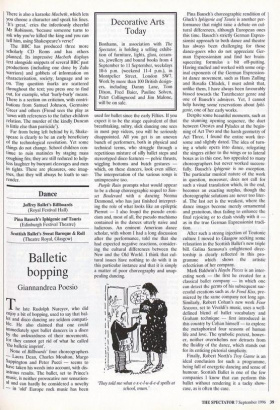Dance
JolTrey Ballet's Billboards (Royal Festival Hall)
Pina Bausch's Iphigenie auf Tauris (Edinburgh Festival Theatre) Scottish Ballet's Sweat Baroque & Roll (Theatre Royal, Glasgow)
Balletic bopping
Giannandrea Poesio
The late Rudolph Nureyev, who did enjoy a bit of bopping, used to say that bal- let and disco dancing are seldom compati- ble. He also claimed that one could immediately spot ballet dancers in a disco by the awkwardness of their movements, `the they cannot get rid of what he called the balletic imprint'. None of Billboards' four choreographers Laura Dean, Charles Moulton, Margo Sappington and Peter Pucci — seems to have taken his words into account, with dis- astrous results. The ballet, set to Prince's music, is neither provocative nor sensation- al and can hardly be considered a novelty
in 'old' Europe rock music has been used for ballet since the early Fifties. If you expect it to be the stage equivalent of that breathtaking, sultry, slick dancing one sees in most pop videos, you will be seriously disappointed. All you get is an uneven bunch of performers, both in physical and technical terms, who struggle through a repetitious mixture of silly ballet steps and stereotyped disco features — pelvic thrusts, wiggling bottoms and butch gestures which, on these dancers, look even sillier. The interpretation of the various songs is unimpressive too.
Purple Rain prompts what would appear to be a cheap choreographic sequel to Sun- set Boulevard with a dancing Norma Desmond, who has just finished interpret- ing the role of what looks like an epileptic Pierrot — I also found the pseudo eroti- cism and, most of all, the pseudo machismo contained in the dances utterly naive and ludicrous. An eminent American dance scholar, with whom I had a long discussion after the performance, told me that she had expected negative reactions, consider- ing the cultural differences between the New and the Old World. I think that cul- tural issues have nothing to do with it in this particular instance and that it is simply a matter of poor choreography and unap- pealing dancing.
`They told me what e-x-c-l-u-d-e-d spells at school, mum.'
Pina Bausch's choreographic rendition of Gluck's Iphigenie auf Tauris is another per- formance that might raise a debate on cul- tural differences, although European ones this time. Bausch's strictly German Expres- sionist approach to both dance and theatre has always been challenging for those dance-goers who do not appreciate Ger- man Expressionism and find her brain- squeezing formulas a bit off-putting. Having studied and worked with some orig- inal exponents of the German Expression- ist dance movement, such as Hans Zulling and Rosalia Chladek, I must admit that, unlike them, I have always been favourably biased towards the Tanztheater genre and one of Bausch's admirers. Yet, I cannot help having some reservations about Iphi- genie, one of her early works.
Despite some beautiful moments, such as the stunning opening sequence, the duet between Orestes and Pylades at the begin- ning of Act Two and the harsh geometry of Act Three, I found the entire work tire- some and slightly dated. The idea of turn- ing a whole opera into dance, relegating the singers either to the wings or to lateral boxes as in this case, has appealed to many choreographers but never worked success- fully. Bausch's Iphigenie is no exception. The particular musical nature of the work in question, moreover, does not call for such a visual translation which, in the end, becomes an exacting surplus, though the choreographic solutions are never too liter- al. The last act is the weakest, where the dance images become merely ornamental and gratuitous, thus failing to enhance the final rejoicing or to clash vividly with it as in the true German Expressionist tradi- tion.
After such a strong injection of Teutonic culture I moved to Glasgow seeking some relaxation in the Scottish Ballet's new triple bill. Galina Samsova's enlightened direc- torship is clearly reflected in this pro- gramme which shows the artistic eclecticism of her company.
Mark Baldwin's Haydn Pieces is an inter- esting work — the first he created for a classical ballet company — in which one can detect the germs of his subsequent suc- cessful creations such as Ae Fond Kiss, pre- miered by the same company not long ago. Similarly, Robert Cohan's new work Four Seasons, set to Vivaldi's music, uses a well- defined blend of ballet vocabulary and Graham technique — first introduced in this country by Cohan himself — to explore the metaphorical four seasons of human life and love. The symbolic pretext, howev- er, neither overwhelms nor detracts from the fluidity of the dance, which stands out for its enticing pictorial simplicity.
Finally, Robert North's Troy Game is an ideal conclusion for such a programme, being full of energetic dancing and sense of humour. Scottish Ballet is one of the few companies I know that can perform this ballet without rendering it a tacky show- case, as is often the case.


























































 Previous page
Previous page